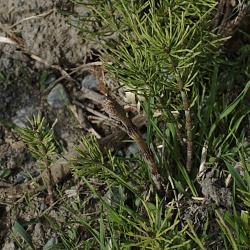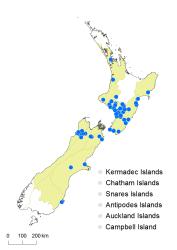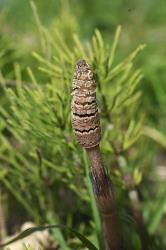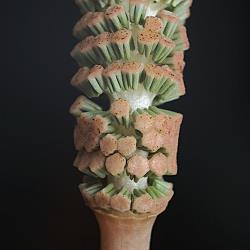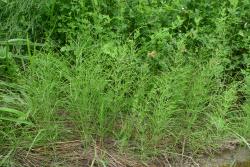- Taxon
- Weed
- Gallery
Aerial stems dimorphic. Sterile stems erect, 100–800 mm high, 1–5 mm in diameter, green, usually regularly branched, with undivided lateral branches arising in whorls; main stem occasionally producing terminal strobili in mid-summer; stem ridges nearly smooth; grooves 4–14; central hollow < half the diameter of the stem; leaf sheaths green with brown tips, 4–10 mm long. Fertile stems 95–275 mm high, 1–3 mm in diameter, pale brown, lacking chlorophyll, unbranched; normally appearing in spring before the sterile stems, and dying after shedding spores; leaf sheaths pale green or brown with darker teeth, 9–22 mm long. Strobili 4–40 mm long, 5–10 mm in diameter, apices obtuse.
Equisetum arvense is recognised by its dimorphic fertile and sterile stems, its abundantly branching vegetative stems that have uniformly green leaf sheaths with 4–14 grooves, and its obtuse strobilus. It is easily the most common of the species in New Zealand, frequently dominating river-banks and other sites where it has become established.
North Island: Auckland, Gisborne, Taranaki, Southern North Island.
South Island: Western Nelson, Sounds Nelson, Marlborough, Westland, Canterbury, Otago.
Altitudinal range: 0–670 m.
A widespread northern temperate species now extensively naturalised in the Manawatu and Rangitīkei catchments of the North Island, and the Mokihinui and Matiri catchments in the South Island. It is also naturalised in Auckland, Kāwhia, New Plymouth, Gisborne, Hawke’s Bay, eastern and southern Wairarapa, parts of Marlborough, Christchurch, Ashburton and Otago Peninsula. It occurs most frequently in lowland sites along river banks, but has been recorded up to 560 m at Mataroa, near Taihape, and 670 m in the Marino Mts, Nelson.
It was first recorded in the wild from Wanganui and was believed to have been introduced with iris rhizomes from Japan (Atkinson 1922). It has spread from there throughout the Manawatu and Rangitīkei catchments as far as Taihape and Palmerston North. It is dispersed easily in river shingle and sand, while in urban areas it has spread with other garden plants, or sometimes been misguidedly cultivated. It now occurs in a substantial part of central New Zealand and will inevitably spread further.
Equisetum arvense occurs most frequently along muddy banks of lakes and rivers, in river shingle and sand, along drains and the edges of swamps, in damp grass, in wet dune hollows, around shingle piles, and as a weed of cultivation in urban areas. It is an aggressive weed in sandy and muddy soils because of its extensive underground rhizomes, and frequently excludes other vegetation. It is almost impossible to eradicate once established, and is not readily susceptible to chemical control (James & Rahman 2010). In urban areas, stems are capable of pushing up through tar seal.
Atkinson (1922, p. 290). Voucher: AK 110803, 1922
Equisetum arvense in the Northern Hemisphere has been documented by Hauke (1967), and its coning behaviour in New Zealand described by Brownsey et al. (1985). In New Zealand E. arvense is an Unwanted Organism.



